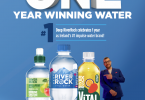Alcohol e-commerce to grow 66% by 2025

By 2025 e-commerce is projected to represent about 6% of all off-trade beverage alcohol volume sales compared to less than 2% in 2018.
And the IWSR research shows younger legal drinking-age consumers driving a shift from ‘traditional’ e-commerce channels to more ‘modern’ app-led online platforms.
Among the 16 focus markets examined in the report (Australia, Brazil, Canada, China, Colombia, France, Germany, Italy, Japan, Mexico, Netherlands, Nigeria, South Africa, Spain, the UK and the US), e-commerce value increased by about 12% in 2019 and then by almost 43% in 2020 during the height of the pandemic.
Looking ahead to
The greatest forecast for the growth of e-commerce value comes from the US, thanks to average annual growth in the country of about 20% which will see it become the top global market for online beverage alcohol.
China, which currently accounts for a third of total e-commerce value, is expected to expand less rapidly but still contribute substantial value.
The IWSR study also found that online business models for alcohol sales are becoming more diverse, leading consumers to increasingly shift between channels and retailers according to their specific needs at any given time.
In general terms, the online beverage alcohol space can be perceived as two distinct but overlapping worlds: more ‘traditional’ e-commerce – often omnichannel or online specialists – accessed via websites and used by older consumers seeking good prices and known brands, who’re prepared to wait for delivery; and more ‘modern’ app-driven e-commerce – often on-demand or marketplaces – used by younger legal drinking-age consumers willing to pay for rapid delivery and looking for interesting/premium brands.
“Given the pandemic and overall changing consumer shopping behaviour it’s certainly not surprising that alcohol e-commerce is growing very quickly,” says Guy Wolfe, Strategic Insights Manager, IWSR Drinks Market Analysis, “But what’s interesting is to see the significant variations that have developed both across and within markets in how different consumer groups shop via e-commerce and what their priorities are.
“e-commerce has clearly become engrained for many consumers, cementing its place as the third sales channel for beverage alcohol purchase.”
IWSR found that around one-quarter of alcohol drinkers across the globe report buying alcohol online, with two-thirds having made their first purchase pre-pandemic.
China has the highest proportion of online shoppers among all beverage alcohol buyers at nearly 60% and the US has the highest proportion of online buyers who made their first purchase during the pandemic (54%).
In most markets wine is the largest major alcoholic drinks category in e-commerce (representing about 40% of total e-commerce value), with notable exceptions being China, Colombia, Mexico and Nigeria, where spirits lead online sales by value.
Although currently accounting for less than one-fifth of total e-commerce value, beer, cider, and RTDs are expected to grow strongly over the next five years, gaining share mainly from wine.








